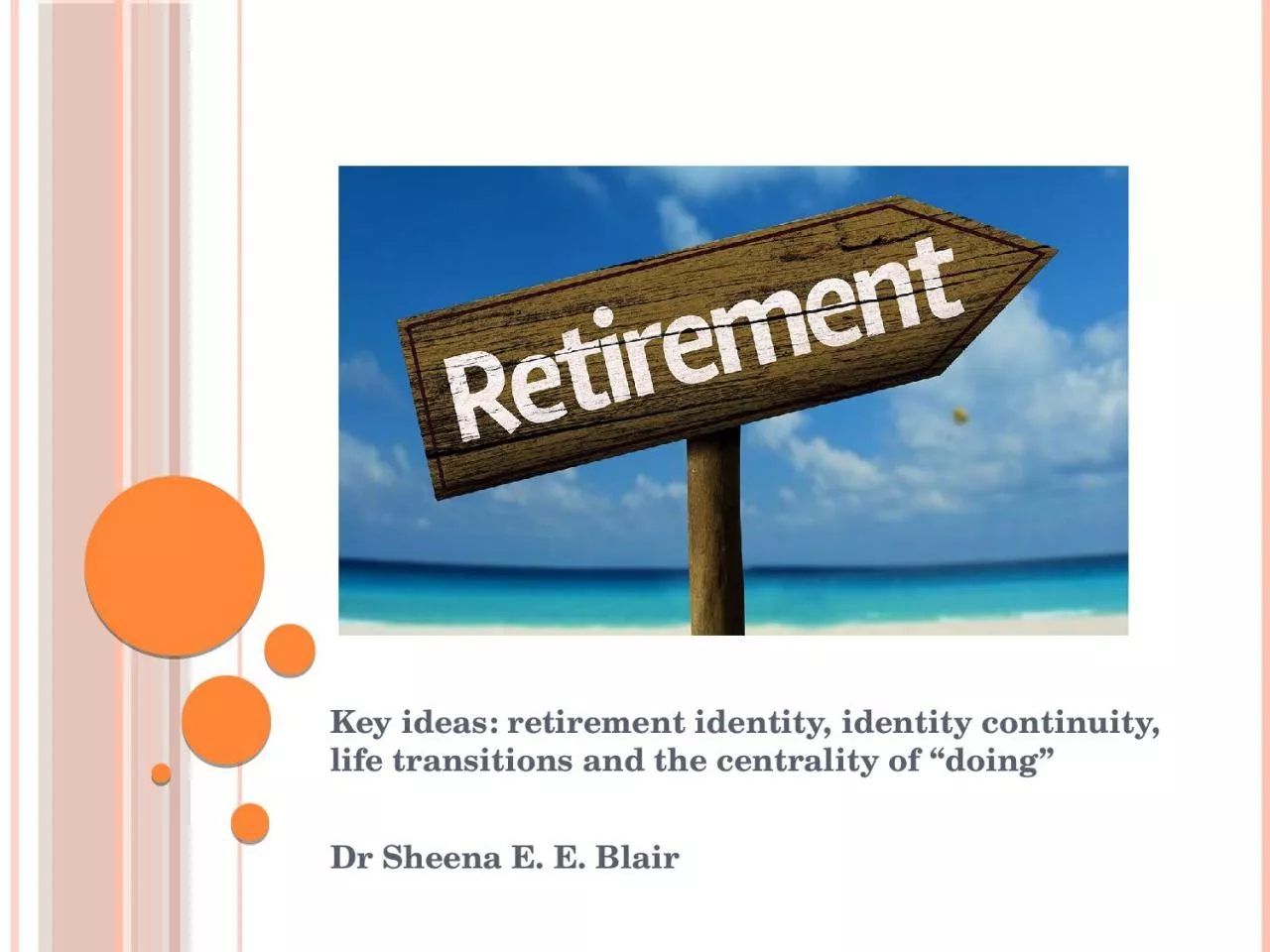

Dr Sheena E E Blair My disclaimer My talk is not intended as a blueprint for how to retire or even how to reflect upon retirement That life transition is unique and multilayered It requires negotiation and renegotiation with self over time ID: 1039116
Download Presentation The PPT/PDF document "Key ideas: retirement identity, identity..." is the property of its rightful owner. Permission is granted to download and print the materials on this web site for personal, non-commercial use only, and to display it on your personal computer provided you do not modify the materials and that you retain all copyright notices contained in the materials. By downloading content from our website, you accept the terms of this agreement.
1. Key ideas: retirement identity, identity continuity, life transitions and the centrality of “doing”Dr Sheena E. E. Blair
2. My disclaimerMy talk is not intended as a blueprint for how to retire or even how to reflect upon retirementThat life transition is unique and multi-layeredIt requires negotiation and re-negotiation with self over timeHoweverPrompted by the notion that amongst all the preparations for retirement, the socio-emotional and rethinking of our occupational lives (what we actually do or will do) can be overlooked
3. Theoretical Ideas which inform the presentationThe Psychology of Life Transitions: how this helps make sense of retirement, identity continuity and can highlight potential resilience factorsIdeas from Occupational Science about the centrality of doing in our lives, how this contributes to our identity and life balance
4. Brief profileAge 72, live alone, two children and one grandsonRetired occupational therapist and educationalistBeen retired from full time post for 12 years and from part time post for 10 yearsFor last ten years I have worked as a freelance educationalistHave ad hoc post as an Assistant Registrar conducting weddings Hobbies include gardening, Pilates, walking, cooking, upcycling, reading and travel
5. Aspects of Identity
6. What do the last two slides say about identity and constructing identity?They reveal chosen and valued rolesAttempts to negotiate retirementChosen alternatives to previous work but retaining some key components/traitsKey influences in terms of chosen theoretical ideas – those which shape thinkingReveals continuity of informing ideasLongstanding fascination with what people do, the form that this takes, the function it occupies but most importantly – what it means
7. Ideas from life transitions A life transition has been explained as a discontinuity A transition can have specific characteristics such as whether it is predictable/voluntaryIt can test our ability to adjustIdentity can remain linked (by you and others) to previous important roles…..did you not used to be?Retirement often runs concurrently with other important life transitions concerning for example health, caring responsibilitiesBy the time of retirement, we have successfully negotiated many other transitions and built some resilience
8. Retirement is a significant transitional eventArguably predictable and voluntaryPlanning for retirement usually occurs but the attention to emotional, social issues and what we will do with more time than we have had in decades can be overlookedWho will we be, what will we do, how will we structure our days, weeks and yearsIt often coincides with other life events such as caring responsibilities, changes in family structureMultiple transition events can strain the ability to adjust
9. ideas from life transitions We build capacity for adaptation and resilienceWe strive to achieve a sense of control, continuity and meaningfulnessLife transitions impact upon our sense of self, identity and self esteemNeed to recognise and acknowledge our stability factors – people, ideas, places, faith or objectsHow to make transitions safe and the idea of transitional objects
10. How do we construct or reconstruct identity post retirement?
11. Understanding the pivotal contribution of occupation Retirement is an occupational transitionNew rhythms, patterns, constellations of doing and balance of activityCreating a new sense of self in the process
12. An occupational scientists viewForm – what are the patterns, roles and range of activities characterising our livesFunction – what are the chosen occupations for – self maintenance, leisure, social, creative, spiritual….Meaning – what is invested in the chosen occupations. This is the most crucial for reflecting upon our identity and retirement identity
13. Concluding ideas in words and picturesThere is copious literature on key organisational issues of retirement and less upon what it means to retire or how to make sense of a new sense of self and identityOur sense of self and identity is constantly re-framing - especially at the time of a life transition and retirement is a major life transitionIdeas from social psychology and occupational science can assist in thinking, re-thinking and sense making of retirement
14. Remember how theCreate your own retirement fingerpost titles!Remember how the opening slide had only one direction (retirement) on the fingerpost?Now create your own multiple directions on your own fingerpost
15. Retirement can be a time for an “encore” career; for tapping into potential; decompressing and joyMy view is that you need time to reflect upon and consider who you are, what you want to do and be